PR-6170RUK Science A STEM Approach - Primary 1
Create successful ePaper yourself
Turn your PDF publications into a flip-book with our unique Google optimized e-Paper software.
Earth and the Environment<br />
DAILY AND SEASONAL CHANGES<br />
Lesson 6<br />
Lesson Plan<br />
Introduction:<br />
1. Ask the pupils; In which month were they born? What season is their birthday? (It may be prudent to<br />
have a list of birthday months for the pupils in your class). As children give their answers, write their<br />
names on an enlarged version of page 132. Explain to them that this is a very simple calendar that<br />
shows the four seasons of the year.<br />
2. Give each pupil a copy of page 133 and ask them to draw a picture of themselves celebrating their<br />
birthday in the correct season. Ask them to leave enough space for other drawings to be added to<br />
the calendar.<br />
Development:<br />
3. Show the online video Learn about Festivals . Show it once to<br />
allow pupils to understand the theme behind the video. Play it again and stop the video after each<br />
‘festival’. Using a think-pair-share, pupils describe their experiences of the festival, what happens at<br />
the festival and the religion from which the festival comes from. Depending upon the community<br />
that your schools serves, answers will be very different and there may be some festivals that will<br />
need to be explored further with the pupils. (This can be achieved through whole class web<br />
searches on an interactive whiteboard).<br />
Ask the pupils whether they know which festivals occur in which seasons. Some are quite easy,<br />
such as Christmas in the winter. Some other festivals may need exploring further using whole<br />
class web searches on an interactive whiteboard. Add the names of the festivals to the enlarged<br />
calendar in the correct season.<br />
4. Ask the pupils to select some festivals that they have enjoyed and ask them to draw a picture that<br />
symbolises that festival in the correct season of the calendar. (Note some festivals, such as Eid<br />
change each year and so the exact season may need checking).<br />
Shrove Tuesday (Pancake Day) may be another celebration that pupils are aware of and may<br />
have experienced.<br />
5. Ask pupils about other festivals that they celebrate that are not religious; for example, Halloween.<br />
6. Consolidate learning from previous lessons by asking the children to include some other drawings<br />
on their calendar that are particular to the seasons. These could include:<br />
• Weather – sunshine in the summer, snow in the winter<br />
• What you wear<br />
• Where you go<br />
• What you do<br />
• Plants flowering in the spring and leaves dropping off trees in the autumn<br />
Differentiation<br />
• Less able pupils may work with adult support, prompting and discussing with pupils the<br />
different celebrations throughout their year. Adults may help pupils to decide which season to<br />
place them in and prompt them with some ideas from Stage 5.<br />
• More able pupils may add more detail and other celebrations and events from their life and<br />
their family.<br />
Viewing sample<br />
Reflection:<br />
7. Bring pupils together and invite them to share their calendars with the rest of the class and talk<br />
through some of the main events, celebrations and festivals that occur in their year.<br />
www.prim-ed.com – Prim-Ed Publishing 978-1-912760-14-5 Infants<br />
<strong>Science</strong>:<br />
A <strong>STEM</strong> AP<strong>PR</strong>OACH<br />
131


















